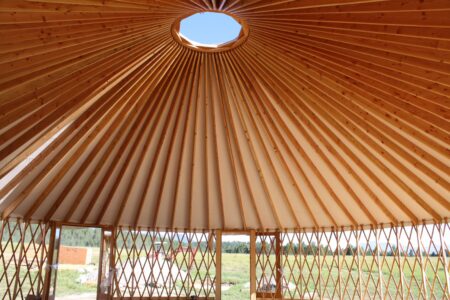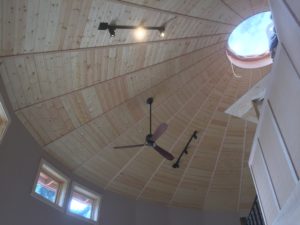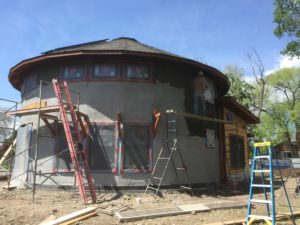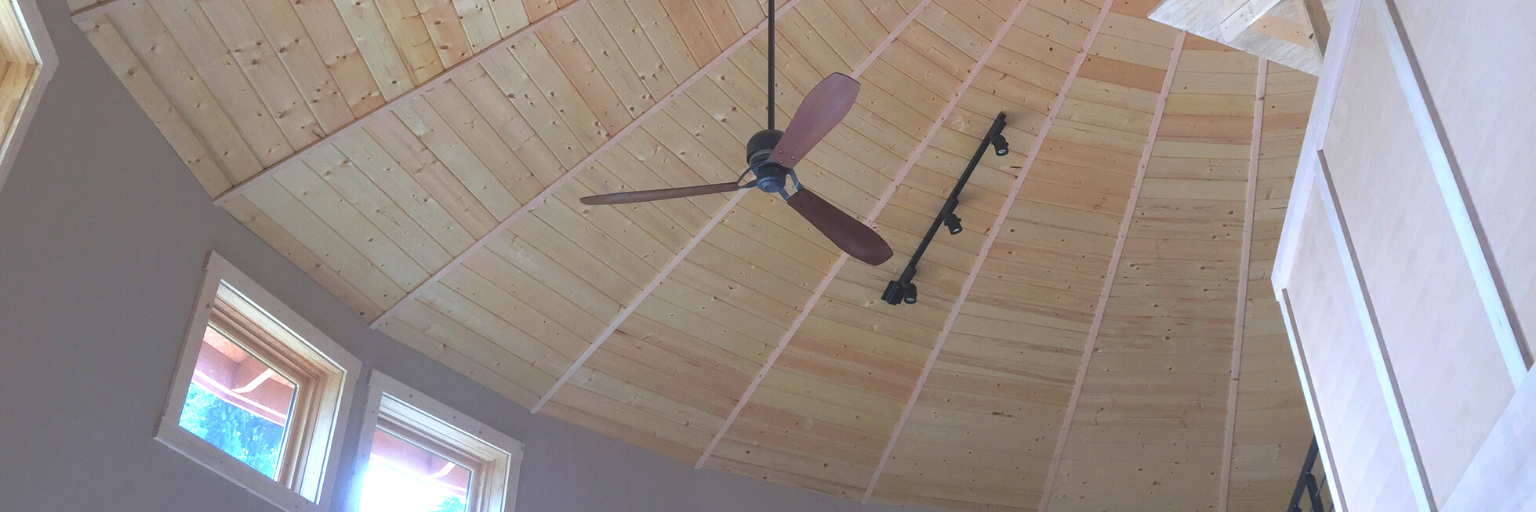Looking into wooden yurts for your next vacation home or second structure? We love yurts of all shapes, sizes, and materials at Shelter Designs! While we offer fabric yurts for sale, the concept of yurt living as a sustainable and adventurous alternative is what we’ve built our lives around. What is it about wooden yurts that everyone finds so interesting? Are there benefits to living in a fabric yurt vs a wooden yurt? Well, perhaps we can help with that. Here is the good and the bad of both wooden and fabric yurts and what considerations you should make before a purchase.

Overview: Wooden vs Fabric Yurts
Both styles of yurts operate under the same engineering principles of tension and compression with a vaulted ceiling that holds itself up without the need for central supports (typically). So, what separates them from each other? The main differences are:
- Cost
- Insulation
- Portability
- Assembly
- Longevity & Maintenance
Cost Comparison
Wooden Yurts
- Generally more expensive upfront, because you must supply additional finishes: insulation, wiring, plumbing, interior walls, flooring, etc.
- The “kit” often includes just the structural frame, roof sheathing, rafters, and wall panels (with or without window/door rough openings).
- After assembly, the finish-out (drywall, flooring, plumbing) may rival costs of conventional home construction.
Fabric Yurt
- More turnkey: Shelter Designs’ fabric yurts often arrive with walls, roofing, insulation, interior finish, windows, doors, and flooring already included.
- Less “hidden cost” later, since many components are built in by the manufacturer.
- Lower labor burden in finish-out stages.
Interested in pricing one of our fabric yurts? Visit our yurt cost calculator to get started.
Yurt Insulation & Thermal Options
One advantage of the wooden yurt over fabric yurts is that they can be insulated with traditional modern-day insulation (fiberglass, rock wool, foam, etc), giving them a higher R value than a modern-day fabric yurt. This is an appealing thing for some customers who are looking for a building envelope that will perform more in line with modern-day stick-built homes. Because in the end, that’s what a wooden yurt is – a stick-built home that happens to be round!
Yurt Portability Differences
If mobility or relocation is a priority, fabric yurts generally win.
- Wooden Yurt: Usually considered permanent; disassembly and moving is costly or impractical.
- Fabric Yurt: Can be disassembled, packed, moved, and reassembled. Useful for semi-permanent or mobile setups.
If you plan to establish a long-term residence in one location, the portability advantage may be less relevant.


Wooden vs Fabric Yurt Assembly, Maintenance & Durability
Assembly
- Wooden yurts: The frame and structure may be erected relatively quickly by a skilled crew, but the interior and exterior finish work (drywall, insulation, trim, plumbing, wiring) is extensive.
- Fabric yurts: Faster to erect and fewer trades required to fully assemble a yurt. Still labor-intensive, but less finishing work afterward. A fabric yurt can be set up and taken down relatively easily compared to a wooden yurt.
Shelter Designs yurts are built using all nuts and bolts, and screws – there are no nails! The assembly of our 40’ yurt is expected to take approximately 5-7 days, and you are ready to move into a warm, dry, and attractively finished interior.
Maintenance
- Wood: Needs protection against moisture, rot, and insect damage. Maintenance of sealants and coatings is vital.
- Fabric: Subject to wear, UV degradation, tears, and seam failure. May need periodic repair or replacement. Fabric panels offer modular replacement if sections get damaged.
Durability
- A well-built and maintained wooden yurt can last for decades.
- A fabric yurt, depending on materials and climate, may require maintenance or partial replacement after a couple of decades.
Key Takeaways & Things to Know
-
Wooden yurts are permanent; fabric yurts are portable.
-
Fabric yurts come ready to live in; wooden yurts require extensive finishing.
-
Assembly time: fabric yurts ~5–7 days; wooden yurts can take months.
-
Insulation: wooden yurts can achieve higher R-values; fabric yurts are pre-insulated.
-
Costs: the upfront cost is higher for wooden yurts; fabric yurts are more budget-friendly.
-
Use the Yurt Cost Calculator to run side-by-side comparisons.
-
Consult with Shelter Designs’ team to tailor the wall, roof, and floor systems to your climate, budget, and usage goals.
In the end, there is no right or wrong answer on which yurt will best suit your needs. We love frame panel wooden yurts and think that they fill a great niche in today’s yurt market! As we always say, we want you to get the product best suited for your needs, not what helps our bottom line out the best. If a frame panel yurt is your best bet then do your research and pick the best company for you. If a fabric yurt is for you then we know that we are making the finest yurts on the market today and look forward to working with you. Happy yurting!
To learn more about our yurts for sale, explore our yurt kits page where you can customize your yurt online and begin planning for the cost of your yurt.
Frequently Asked Questions About Wooden and Fabric Yurts
What is the difference between a wooden yurt and a fabric yurt?
Wooden yurts (frame panel yurts) are permanent, stick-built structures with the ability to use traditional insulation and higher R-values, while fabric yurts are portable, come pre-insulated, and have a finished interior ready for immediate use.
Are wooden yurts more expensive than fabric yurts?
Yes, wooden yurts typically cost more overall because they require additional materials like insulation, interior wall and roof finishes, electrical wiring, plumbing, and flooring, whereas fabric yurts include these features in the kit.
Which yurt is better for portability?
Fabric yurts are easier to transport and take down, making them ideal for customers who want a flexible or movable structure. Wooden yurts are permanent and cannot be disassembled after construction.
How long does it take to assemble a wooden yurt vs a fabric yurt?
A large fabric yurt from Shelter Designs can typically be assembled in 5–7 days with bolts and screws. Wooden frame panel yurts require professional carpentry, equipment, and additional months of interior and exterior finishing.
Can wooden yurts be insulated like a regular home?
Yes, wooden yurts can be insulated with modern materials such as fiberglass, rock wool, or foam, which allows for higher energy efficiency and performance similar to conventional stick-built homes.
Is a wooden yurt considered a permanent structure?
Yes, wooden yurts are designed as permanent structures with fixed foundations and require professional assembly, whereas fabric yurts are semi-permanent and portable.


